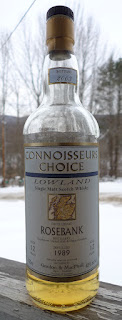stats: single malt scotch, Lowlands, 80 proof, $50
When I first became aware of the phenomenon of closed distilleries and their finite stocks of whisky which would eventually disappear forever, I viewed the situation with a sense of tragic loss. Something special, something unique and irreplaceable was being lost to the tumultuous up and downs of an unpredictable industry.
But over the years my outlook has grown to be much more philosophical. When stills go silent, their whiskies gain a certain mystique. Some of these malts would go unnoticed by most, with the bulk of their production ending up in blends, were it not for the attention drawn to them by the closure of their distilleries. This really adds to the intrigue and allure of Scotch whisky, in my opinion.
I now view these losses as an integral part of a cycle, and with endings come new beginnings. Mothballed stills have been relocated and repurposed in new endeavors or restoration projects. Long defunct distilleries have come back into operation, decades or more after closing, even if only in name. The expansion periods can even give birth to entirely new distilleries.
Littlemill was a Lowland distillery with many owners over its long history, possibly going back as far as the mid 1700’s. The Lowland tradition of triple distillation was practiced until the short closure of 1929 – 1931. Upon reopening under new ownership, the switch was made to double distillation. The operation was supposedly mothballed from 1984 – 1989, but the bottling I have claims to have been distilled in 1985, so there is a slight discrepancy there. Littlemill was modernized and reopened in 1989, but only made it to 1994 before closing again when its owners went bankrupt. The equipment was dismantled in 1997, and plans to restart production never came to fruition. The remaining buildings were lost to fire in 2004.
Straw in color, it is ever so slightly lighter than the Rosebank reviewed in the last post. The nose has a good amount of density, going a bit floral / piney. This is rather big on the palate, surprising considering its modest 80 proof. The flavor profile starts off fruity then it drifts into the realm of cat pee, but not to the point of being detrimental. It eventually turns to warming oak flavors. Good complexity, it evolves nicely from the start through the lengthy finish.


